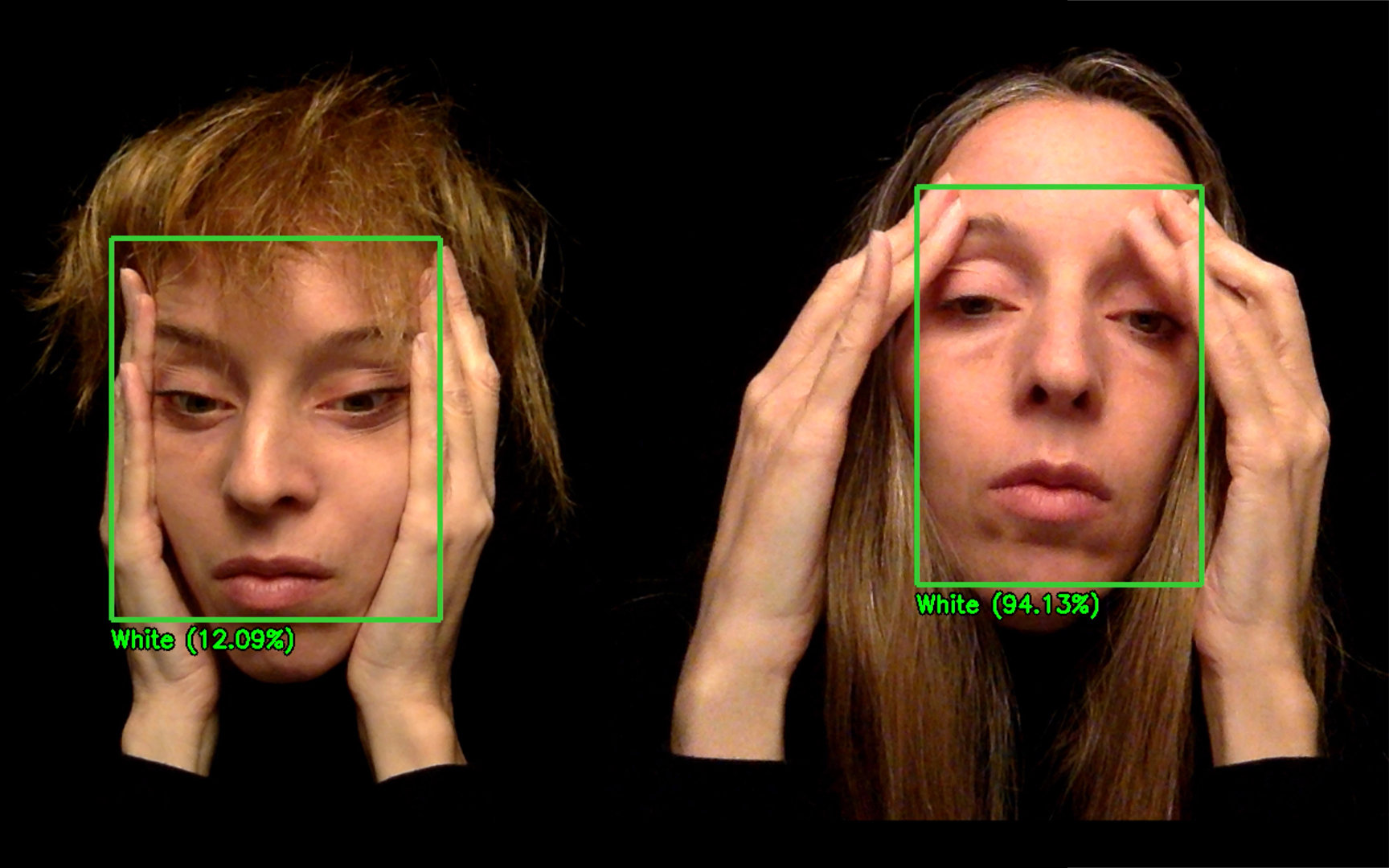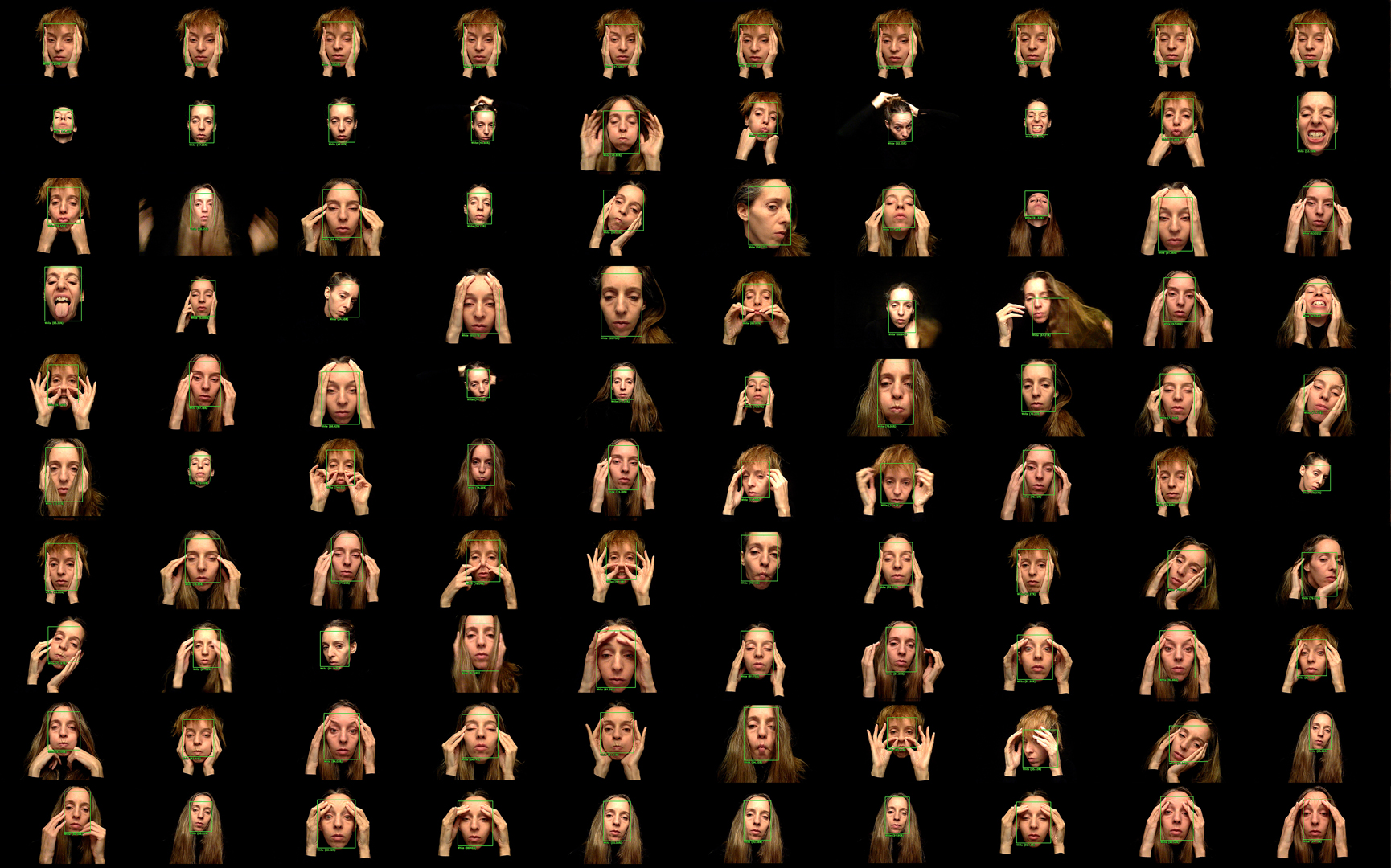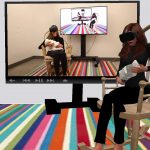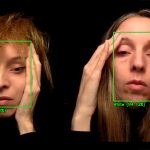Avital Meshi: Deconstructing Whiteness
Artist(s):
Title:
- Deconstructing Whiteness
Exhibition:
- SIGGRAPH Asia 2020: Untitled & Untied
-
More artworks from SIGGRAPH Asia 2020:


Category:
Artist Statement:
Summary
Deconstructing Whiteness is an interactive performance which examines racial visibility through AI recognition systems. The artist resists her own visibility as a ‘white’ person by utilizing a performative behavior. The underlying structural racism is revealed as well as our own agency to act upon and sabotage the machinic vision.
Abstract
Deconstructing Whiteness is an interactive AI performance. It examines the visibility of race in general, and ‘whiteness’ in particular, through the lens of AI technology and reveals the underlying racial constructs which compose the technological visibility of race. The artist uses an off-the-shelf face recognition program to resist her own visibility as a ‘white’ person. By utilizing a performative behavior she slightly changes her facial expressions and her hair style and modifies the confidence level by which the machine recognizes her as ‘White’.
Face recognition algorithms are becoming increasingly prevalent in our environment. They are embedded in products and services we use on a daily basis. Recent studies demonstrate that many face recognition algorithms reflect social disparities and biases which may harshly impact people’s lives. This is especially true for people from minority and underrepresented groups. Scholar Paul Preciado claims that if machine vision algorithms can guess facets of our identity based on our external appearance, it is not because these facets are natural features to be read, it is simply because we are teaching our machines the language of techno-patriarchal binarism and racism. However, it is important to remember that these systems are not ‘things-of-themselves’; there is no reason for them to be outside of our reach. We are able to intermingle with these systems so that we better understand the coupling between the information and our own bodies. This entanglement, as seen in the performance, reveals our own agency and ability to act.
In Deconstructing Whiteness the ‘White’ and ‘Non-white’ dichotomy is ditched in favor of a flow of probablities which are meant to resist, confuse and sabotage the machinic vision and its underlying structural racism.
The performance can either be carried as a live online performance, a video documentation or a photographic collage.
Technical Information:
Deconstructing Whiteness can either be carried as a live online performance, a video documentation or a photographic collage. The live online version of it will be taking place in an online conference meeting (such as a Zoom meeting). The artist will be sharing her screen on which her own image will be apparent. This image will be analyzed in real-time by an AI face recognition system which estimates the racial label ‘White’. During the performance the artist will change her facial expressions and her hair style in an attempt to confuse the AI system and make it be less or more confident regarding the artist’s visibility as ‘White’. In the case the project cannot be shown as a live performance it can be exhibited as a documentation piece of the performance itself. This include a video piece and a photographic collage which shows that different facial expressions and their AI analysis.
Process Information:
The project was conceptualized a few weeks before the murder of George Floyd. This awful event and the resulting BLM momentum which followed it, encouraged me to complete the first version of this investigation and to start showing it to others. I am interested in continuing to develop this work by inviting others to explore their own racial visibility, too.
This piece is not the first one in which I explore racial visibility, but I must admit that each time I touch this theme I need to harness my confidence before I present my work. Deconstructing Whiteness was released at a very sensitive moment and I wasn’t sure how people would respond to it. With some of my previous race-related work there were some harsh discussions and discouraging critiques. There were moments I was told I do not know enough to participate in the conversation. When something like this occurs, I step back, I ask questions, I read, and I do my best to learn, but I always try to come back to the conversation. Even if I make mistakes and even if the work can be further developed, my intentions are anti-racist and I find this conversation too important to watch from the sidelines. I strive to become an ally to those who suffer from racism.
Other Information:
Inspiration Behind the Project
Deconstructing Whiteness is an exploration of my own racial visibility as it is seen through an AI algorithm. Specifically I examine my visibility as a ‘White’ person. I perform different expressions and hair-styles to the machine to ‘trick’ the algorithm and make it be less or more sure of my ‘whiteness’. The project is inspired by so many important discussions about structural and systemic racism which I heard and participated in. I believe that AI algorithms which classify people according to their race have the potential to reinforce this problem by duplicating racist thinking, embedding it in the code so it becomes hidden within the structure of the system and thus amplifying it. My aim in this project is to demonstrate the problematic nature of algorithms when they attempt to classify race. By spending time with the algorithm I revealed that there are moments in which the system detects me as “White” with almost 100% confidence level, but at other moments this certainty drops dramatically. My ability to ‘trick’ the machine uncovers much of how the system detects race and points out to the fact that the estimation of whiteness does not solely correlate with skin color per se. It also brings up the question whether or not everyone can ‘trick’ the machine in the same way.
Key Takeaways for the Audience
As an artist working with AI technology, I assume the role to raise awareness regarding the incongruence between the technology and the social environment it resides in. AI is a new technology, but it is developing fast. The level of awareness regarding fairness and accountability is growing, too, and hopefully it will soon catch up with the technology. In the meantime I think that it is important that we all become familiar with these algorithms and see how we are seen through their lens. When viewers see my piece I wish for them to be curious about how their own face would have been seen through this specific algorithm. I wish for them to wonder whether or not they think they can ‘trick’ the machine in a similar manner. My hope is that people will find ways to prove themselves that they are not powerless when confronted with these systems.








